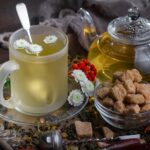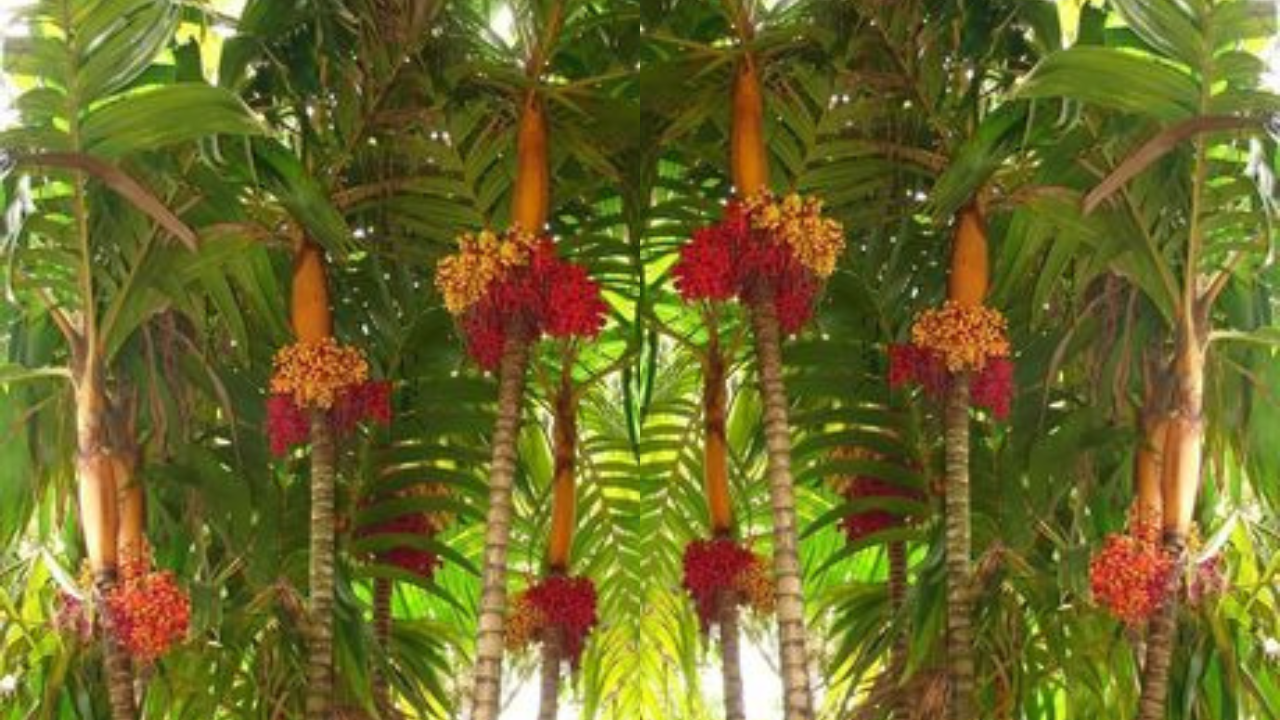The lipstik palm, also known as Cyrtostachys renda, is an eye-catching plant native to Southeast Asia, particularly Malaysia and Indonesia. Its distinctive bright red crownshaft and vibrant green fronds make it a highly sought-after addition to tropical gardens and landscapes. This striking palm is admired not only for its unique beauty but also for its ability to create an exotic, tropical atmosphere wherever it grows.
In this guide, we’ll explore everything you need to know about growing, caring for, and maintaining the lipstick palm to ensure its long-lasting beauty.
What is Lipstick Palm?
The lipstick palm, sometimes referred to as the “red sealing wax palm,” gets its name from the intense, lipstick-red color of its crownshaft, a feature that sets it apart from other palms. It is often used as a statement piece in tropical landscapes, adding drama and flair with its brilliant coloration. Known for its slender, clumping trunks and pinnate leaves, the lipstick palm is a favorite among garden enthusiasts looking to introduce a tropical vibe to their surroundings. However, growing this palm outside its native habitat requires careful attention to its environmental needs.
Why the Lipstick Palm is Special
The lipstick palm’s ornamental value lies in its vivid red coloration, which is rarely seen in other palms. This striking feature makes it a popular choice for landscaping in tropical climates, where it thrives in warm, humid conditions. Its clumping growth pattern and manageable height, typically reaching up to 10-20 feet when cultivated, make it an ideal centerpiece for gardens, parks, and even indoor spaces (with proper care). The palm’s ability to grow in wet soil conditions, including marshy areas, further enhances its versatility for garden designs.
Growing Lipstick Palm
While the lipstick palm is undoubtedly beautiful, it can be challenging to grow outside tropical regions. This palm has very specific growing conditions, which, if met, will reward you with a healthy, thriving plant.
Climate Requirements
The lipstick palm is a true tropical plant, thriving in warm, humid climates. It prefers temperatures between 75°F and 85°F and will suffer if exposed to temperatures below 60°F. The plant thrives in USDA zones 10-12, making it ideal for regions like Florida, Hawaii, and southern Texas. For gardeners in cooler climates, growing the lipstick palm indoors or in a greenhouse is the best option.
Humidity is another essential factor for this palm’s health. High humidity levels, typically above 50%, are necessary to prevent the leaves from drying out and ensure vibrant growth.
Light Preferences
The lipstick palm prefers partial to full sun. When grown outdoors, it should be placed in a location where it can receive filtered sunlight for at least part of the day. In its natural habitat, the palm grows under the canopy of taller trees, so replicating this environment will help it thrive. If grown indoors, placing the plant near a bright, east-facing window will provide it with enough light to maintain its vivid coloration.
Lipstick Palm Growth Rate
The Lipstick Palm is a slow-growing tropical species, taking several years to reach its mature height of 10 to 15 feet. Under ideal conditions, this palm typically grows about 1 to 2 feet per year. However, it may grow slower in less-than-optimal environments, especially if the palm is exposed to inadequate sunlight or improper watering practices.
Growth rates can also vary depending on whether the palm is grown in a container or planted in the ground. When grown in a pot, the Lipstick Palm’s growth rate can slow further due to restricted root space. For gardeners aiming to accelerate growth, providing the palm with ideal conditions is key.
Caring for Lipstick Palm
Proper care is essential to ensure the lipstick palm remains healthy and vibrant.lipstik palm While the plant can tolerate brief periods of neglect, long-term health depends on consistent care practices, especially regarding watering and soil conditions.
Watering Needs
The lipstick palm loves moisture, and ensuring that the soil stays consistently wet is key to its survival. This plant is native to swampy areas, so it can tolerate standing water and is an excellent choice for gardens with poor drainage. However, be cautious not to let the soil dry out completely between waterings, as this can stress the plant.
When growing the lipstick palm indoors, it’s important to mist the plant regularly to increase humidity levels, especially during the drier winter months. Keeping a humidifier nearby can also help maintain the necessary moisture levels in the air.
Soil and Fertilization
The ideal soil for the lipstick palm is rich, well-draining, and retains moisture well. A mix of loam and peat-based soil will create the perfect environment for the plant’s roots to thrive. Adding organic compost can improve soil structure and provide essential nutrients.
To support its growth, the lipstick palm benefits from regular feeding. Use a slow-release, balanced fertilizer once every three months during the growing season (spring and summer) to promote lush foliage and strong root development. Avoid over-fertilizing, as this can lead to salt buildup in the soil, which may damage the roots.
Propagating Lipstick Palm
Propagating the lipstick palm is not for the faint of heart. This plant is notoriously difficult to propagate from seed, as germination can take several months, and the seedlings are slow-growing. However, with patience and the right conditions, it is possible to grow new lipstick palms from seed.
Seed Propagation
If you want to try propagating the lipstick palm from seed, start by soaking the seeds in warm water for 24-48 hours to soften the outer shell. After soaking, plant the seeds in a container filled with a well-draining soil mix, ideally a combination of peat and sand. lipstik palm Place the container in a warm, humid location with indirect sunlight, and keep the soil consistently moist.
Germination can take anywhere from six months to a year, depending on the conditions. During this time, it’s crucial to maintain high humidity and keep the soil from drying out. Once the seedlings have developed a few sets of leaves, they can be transplanted into larger pots or directly into the garden.
Common Pests and Diseases
Like all plants, the lipstick palm is susceptible to certain pests and diseaseslipstik palm . Knowing how to recognize and treat these issues early will help ensure your plant stays healthy.
Pests
The most common pests that attack lipstick palms include spider mites, scale insects, and mealybugs. These pests can cause the leaves to turn yellow or develop unsightly spots.lipstik palm To control infestations,lipstik palm it’s essential to catch the problem early and treat the plant with insecticidal soap or neem oil.lipstik palm Regularly inspecting your palm for signs of pests will prevent small problems from turning into larger infestations.
Diseases
Root rot is a common issue for lipstick palms, particularly when the soil is too wet for extended periods. Ensuring the plant is grown inlipstik palm well-draining soil can help prevent this problem. If root rot does occur, reduce watering and remove any affected parts of the plant to prevent the disease from spreading.
Lipstick Palm in Landscaping
In tropical and subtropical climates, the lipstick palm can be a stunning addition to your garden design. Its bold colors and striking shape make it perfect for creating a focal point or as part of a larger tropical landscape.
When using lipstick palms in landscaping, consider pairing them with other tropical plants such as bird of paradise, banana trees, or philodendrons to create a lush, lipstik palm vibrant atmosphere. Its love for wet soil makes it an excellent choice for planting around ponds or water features, where it can thrive in the moist environment.
Lipstick Palm as a Houseplant
For those who live in cooler climates, the lipstick palm can be grown as a houseplant, provided it receives adequate light and humidity. While it may not reach the same height as it would outdoors, an indoor lipstick palm can still offer a striking splash of color to any room.
Place the plant near a bright window and use a humidifier or mist the leaves regularly to keep it healthy. While growing the lipstick palm indoors requires more care, the results are well worth the effort for those who want to enjoy the plant’s beauty year-round.
FAQs
What is the best climate for growing lipstick palm?
The llipstik palm palm thrives in tropical climates with warm temperatures (75°F to 85°F) and high humidity levels. It is best suited for USDA zones 10-12.
Can I grow lipstick palm indoors?
Yes, the lipstick palm can be grown indoors in cooler climates, but it requires bright, indirect light and high humidity to thrive.
How often should I water my lipstick palm?
Keep the soil consistently moist, as the lipstick palm prefers wet conditions.lipstik palm Avoid letting the soil dry out completely between waterings.
Is the lipstick palm difficult to propagate?
Yes, propagating the lipstik palm palm can be challenging, especially from seed.lipstik palm The seeds have a slow germination rate, often taking several months to sprout, and require very specific humidity, temperature, and soil conditions to succeed.
What pests should I watch out for on my lipstick palm?
Common pests that may affect the lipstik palm palm include spider mites, mealybugs, and scale insects. Regularly inspect the leaves for any signs of damage or infestation. lipstik palm Treat pests with insecticidal soap or neem oil as soon as they are noticed to prevent widespread damage.











